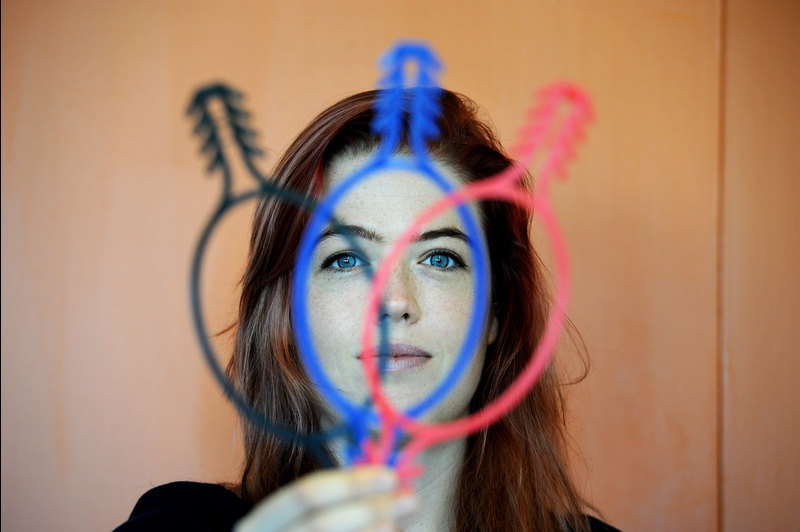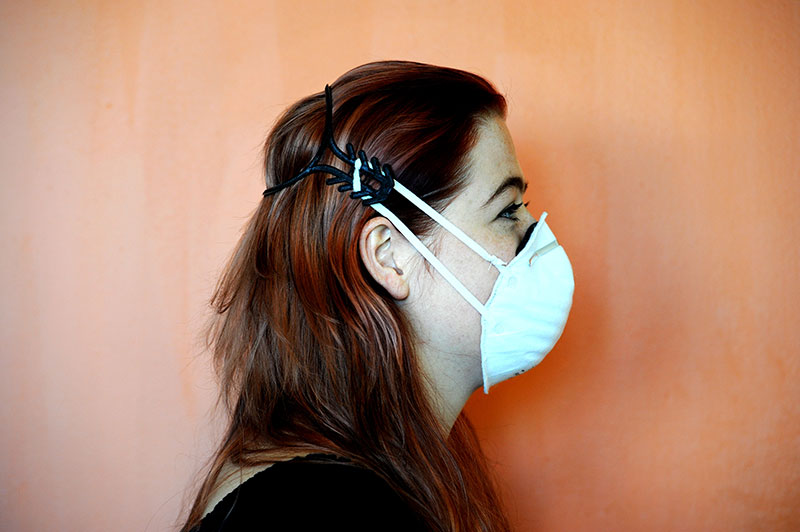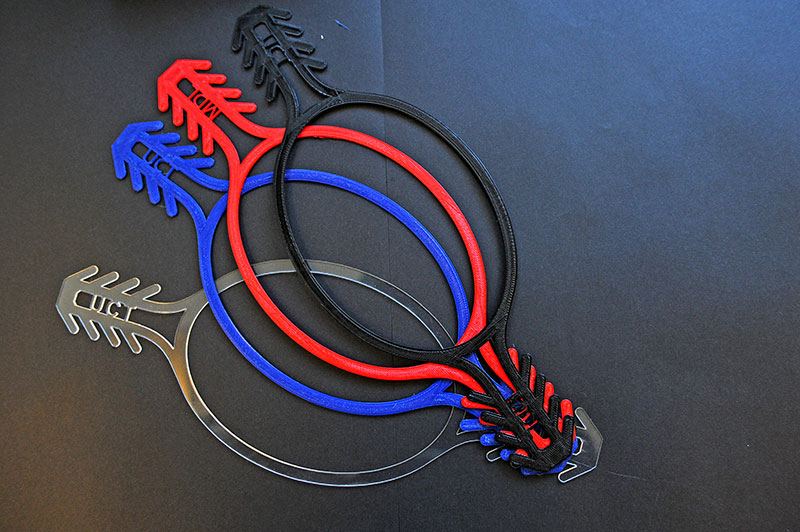Simple tech solution is an ear saver
14 August 2020 | Story Helen Swingler. Photos Lerato Maduna. Voice Lerato Molale Read time 7 min.
University of Cape Town (UCT) MSc student in biomedical engineering Lara Timm calls her ear saver solution the UCT Hearo. It’s a neat and practical design that improves the comfort and fit of face masks with ear loops, typically worn by frontline medical staff working long shifts to contain COVID-19.
Common mask designs have a painfully obvious flaw: they anchor around the ears. They irritate and chafe the skin and often slip, needing to be adjusted and increasing the risk of self-contamination.
The idea for an alternative design came after Timm’s early interactions with clinical partners and members of UCT’s COVID-19 Research Task Team, who complained about the discomforts of wearing a mask fixed around the ears for hours on end.
Though a quick Google search showed several solutions, Timm, a member of UCT’s Medical Devices Laboratory, wanted a fix that would not only eradicate the ear malaise but outperform existing designs.
Simple, effective, cheap
The Hearo is a soft, flexible, oval-shaped device that hugs the crown of the head, ensuring that face masks sit securely and comfortably over the nose and mouth: simple, effective, cheap. And biomedical engineering can be all three, said Timm, who relishes the opportunities that come with devising clever, inexpensive and practical solutions to common problems.

“From a young age, my ideal job was one where I could create something that could have a lasting effect on the people who used or came into contact with it … I’ve always tried to find creative solutions to problems; fixing things that were broken and making things that could be used and admired around the house. I also had an ongoing interest in biology and the functioning of the human body.”
Biomedical engineering fitted the bill for Timm. But her career in the field began in an unlikely way – in architecture. However, satisfying the vagaries of individual clients wasn’t for her. She needed “well-defined needs”, which came with engineering.
It was back to school for her: a BSc(Eng) degree in biomedical engineering from the University of the Witwatersrand (Wits) followed by a BSc(Eng) in electrical (information) engineering, also at Wits. Not yet ready for the workplace, Timm opted for further training via UCT’s more practical and specialised MSc in Biomedical Engineering by coursework and dissertation.
“I can get lost for hours in the process of iterating and modifying these designs to perfection.”
Problem-solving
The field combines her creative, problem-solving side with her interest in human biology and desire to have a lasting impact on those who use her designs.
“The tactile nature of building and prototyping these devices really excites me. I can get lost for hours in the process of iterating and modifying these designs to perfection.”

For the past 18 months, Timm has been honing those skills, designing medical devices under the tutelage of Associate Professor Sudesh Sivarasu, the head of the Medical Devices Laboratory.
“I discovered the UCT Medical Devices Laboratory by chance late one evening Google searching ‘biomedical engineering in South Africa’. I’d always known about the possibilities of using biomedical engineering in the medical imaging field, but was unaware that there was a place where I could develop my product design skills while solving medical device problems in a way that was highly suitable to their context.”
Developing the Hearo has taken Timm on a journey of discovery and challenge. Design was just one aspect; fabrication and production presented other hurdles.
“Hopefully we can get a significant number of Hearos out as soon as possible to ensure we make the biggest impact we can.”
“Initially these devices were being 3D printed,” said Timm. “We could do this in-house using our 3D printers in the lab.”
Although this solution was effective, it was not efficient. With a manufacturing time between 30 and 40 minutes per device, Timm sweated to get a reasonable number out each day. Laser cutting the Hearos would be more efficient, but sourcing materials became difficult, with suppliers experiencing stock delays due to the pandemic, she said.
But finally, she was able to outsource manufacturing to local companies, a boost at a time many were cutting back or closing shop.
“Hopefully we can get a significant number of Hearos out as soon as possible to ensure we make the biggest impact we can.”
Low-cost innovation
Working in the laboratory also introduced Timm to a strategic aspect of biomedical design in Africa, based on the theory of Frugal Biodesign that has been adopted by Sivarasu and his team. Low-cost innovation that suits local context and need is one of Sivarasu’s mantras. It’s one Timm has endorsed wholeheartedly.
“This approach is not only relevant in COVID-19 times,” she added. “In developing economies such as South Africa, the need for simple and context-appropriate solutions is substantial. Frugal Biodesign incorporates the stakeholders to refine the design process so that it has the greatest possible chance of success and collective reach.”
It also considers the limitations faced by developing countries in terms of human, financial and physical resources.
“Developing simple solutions means they can reach the end user sooner.”
“Developing simple solutions means they can reach the end user sooner, which is critical with the fast-paced progression of diseases such as COVID-19.”
The Hearo design reflects this. Timm has designed the device to have a life beyond the immediate surge in the pandemic.
“Surgical masks will remain important in clinical settings long after the pandemic. We are currently in discussion with partners to find a way forward for the Hearo.”
Women in tech
The number of women in the engineering field is growing slowly. At educational institutions such as UCT, there is constant support and encouragement for women across the spectrum of engineering disciplines, said Timm.
“Women are singled out and their work celebrated,” Timm said. “It’s initiatives like this Women’s Month feature that make the field so rewarding.”
The work is varied and exciting for the large number of postgraduates working in the lab. Beyond the COVID-19-related work, these include a low-cost ventilator solution, an open-source prosthetic arm, a mobile hysteroscopy system, a pleural biopsy needle and many others.
As a woman in science, technology, engineering and maths (STEM), Timm believes that she can encourage and inspire other women to consider tech and engineering. However, she sees herself less as a role model and more as a woman with a roadmap “who worked hard to get into a field that inspires me”.
 This work is licensed under a Creative Commons Attribution-NoDerivatives 4.0 International License.
This work is licensed under a Creative Commons Attribution-NoDerivatives 4.0 International License.
Please view the republishing articles page for more information.
Women’s Month at UCT
UCT’s virtual Women’s Day event
Two years after UCT Vice Chancellor Professor Mamokgethi Phakeng launched the For Womxn by Womxn scholarships for the advancement of women in academia, the three grant recipients, Dr Katye Altieri, Professor Floretta Boonzaier and Professor Janet Hapgood delivered brief updates on the status of their research projects. Speaking at the UCT Women’s Day virtual event, For Womxn by Womxn, the three researchers updated the UCT community on their research on oceanography, gendered and sexual violence, and contraception and HIV risks for women in Subs-Saharan Africa.
UCT women in the news
UCT women in technology
UCT News has used the opportunity of Women’s Month to focus on women in technology. Here we feature interviews with some of the University of Cape Town’s brightest innovators who are using tech to advance our understanding of the world, to combat the COVID-19 pandemic and build resilient communities in the face of other health, social and economic challenges.
UCT women teaching excellence
The Distinguished Teacher Award is the highest accolade awarded to teaching staff at all levels within the university. Through the award, the University of Cape Town acknowledges the primary place of teaching and learning in the university’s work. This year, three of the four recipients are women.































